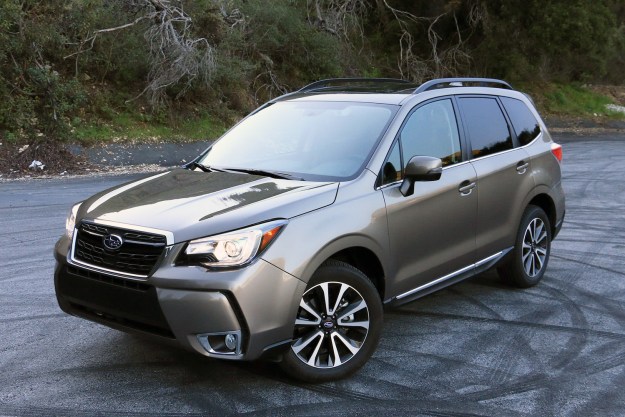Crossovers have replaced sedans at the top of America’s sales chart, and the Toyota RAV4 is the segment’s leader. It was the fourth-best-selling car in the U.S. in 2019, behind perennially popular pickups made by Ford, Ram, and Chevrolet, respectively. The secret to its success is a spacious interior, efficient powertrains, plus a long list of available comfort and safety features in a wallet-friendly package. Its popularity hasn’t gone unnoticed.
One of its main rivals is the Subaru Forester, which has gradually evolved from a wagon to a crossover. Both are strong options if you’re looking for a daily driver. Here’s how they compare, and how they’re different.
Tech features
Toyota RAV4

LE denotes the base RAV4, but it still comes standard with a nice list of tech features including a 7-inch touchscreen, Bluetooth connectivity, Apple CarPlay, Android Auto, a USB port, SiriusXM satellite radio, and Amazon Alexa compatibility. Four additional USB ports are standard on all other trims. On higher trims, the RAV4 offers an 8-inch touchscreen and an optional bundle that includes an 11-speaker JBL audio system. The top infotainment system features the 8-inch touchscreen and the JBL system, and it adds navigation. The standard digital screen in the instrument cluster is a 4.2-inch unit, but upmarket models receive one that stretches 7 inches. Other neat tech features include a digital rearview mirror and wireless smartphone charging; neither is available on the Forester.
Subaru Forester

The Forester’s list of standard tech features includes a 6.5-inch touchscreen for the infotainment system, Bluetooth connectivity, Apple CarPlay, Android Auto, SiriusXM satellite radio, and two USB ports (two additional ports are optional). Like in the RAV4, the more expensive infotainment system is displayed on an 8.0-inch touchscreen, and navigation is found on the upper echelons of the trim hierarchy. An upgraded Rockford Fosgate audio system and a nine-speaker Harman Kardon audio system are available, too. Also, like the RAV4, the Forester comes with a 4.2-inch screen in the instrument cluster, but the upgrade unit is smaller at 6.3 inches.
Performance and fuel economy
Toyota RAV4

The non-hybrid RAV4 has one engine choice, a 2.5-liter four-cylinder backed by an eight-speed automatic transmission. The engine produces 203 horsepower and 184 pound-feet of torque. With front-wheel drive (FWD), the RAV4’s EPA-rated fuel economy is 30 mpg combined while the all-wheel drive (AWD) version is rated between 27 and 30 mpg combined depending on the trim level (the base LE trim is the most efficient and the TRD Off-Road trim the least). The RAV4 Hybrid’s powertrain consists of a 2.5-liter four-cylinder engine, two electric motors, and a continuously variable transmission (CVT). The total system output is 219 hp, and the AWD-only hybrid is rated at an impressive 40 mpg combined. The RAV4 Prime plug-in hybrid is scheduled to arrive for the 2021 model year.
If you have something to tow, keep in mind the Adventure and TRD variants of the RAV4 can tow up to 3,500 pounds. Other trims are rated at 1,500 pounds, while the Hybrid’s towing capacity checks in at 1,750 pounds.
Subaru Forester

Without a hybrid (yet) or front-wheel drive, things are simpler with the Forester. Its 2.5-liter four-cylinder boxer engine develops 182 hp and 176 lb-ft of torque and sends it to the four wheels via a CVT. Fuel economy is pegged at 29 mpg combined, and its towing capacity checks in at 1,500 pounds, which is less than the RAV4’s.
Interior and exterior styling and dimensions
Styling
Exterior and interior styling are very subjective. Like many compact SUVs, neither one is much to look at, but one can argue the RAV4 isn’t as blandly styled as the Forester. Also, the RAV’s Adventure and TRD trims look more rugged than any Forester, something certain buyers are looking for. Inside, the RAV4 offers a sportier look while the Forester provides a more premium one. Fit and finish, material quality, and screen sizes are similar.
Exterior

When it comes to exterior dimensions, both SUVs are almost identical. Length, width, height, and wheelbase are all within two inches of each other. If you’re considering off-roading, ground clearance is also similar, but the Forester just edges out the RAV4. The two bottom RAV4 trims (LE and XLE) have 8.4 inches of ground clearance, and all other trims (including Adventure and TRD) have 8.6 inches. All Forester trims have 8.7 inches of ground clearance.
Interior

It’s a similar case inside. Interior dimensions are almost the same, but the Forester has an inch or two more headroom, legroom, and shoulder room (front and rear seats). The only exception is rear-seat headroom; the RAV4 has more. Moving on to where passengers don’t sit: The cargo area. The RAV4 wins with the rear seats up, offering up to 37.5 cubic feet of space, which is more than the Forester’s 35.7. However, if you fold the seats down, the RAV4 offers 69.8 cubic feet of cargo space versus 73.1 cubes in the Forester.
Safety
Toyota RAV4

Every RAV4 model comes with a suite of driver-assistance features named Toyota Safety Sense 2.0. It includes emergency automatic front braking with pedestrian detection, lane departure alert, lane-keeping assist, lane centering, adaptive cruise control, automatic high beams, and road sign assist. That’s more standard features than the Forester. Blind-spot monitoring, rear cross-traffic alert, and rear automatic braking are optional. In terms of crash safety, the IIHS gave the RAV4 its 2020 Top Safety Pick award and the NHTSA issued its highest five-star overall rating for the Toyota.
Subaru Forester

Every Forester regardless of trim level comes with a suite of standard driver-assistance features Subaru calls EyeSight. The package includes emergency automatic front braking with pedestrian detection, lane departure alert, lane departure prevention, lane centering, and adaptive cruise control. Subaru added LED steering responsive headlights and high-beam assist for 2021. Optional driver-assistance features include driver attention warning, blind-spot monitoring, rear cross-traffic alert, and rear automatic braking. On the crash safety front, the Forester received the IIHS top award, 2020 Top Safety Pick+, and the highest rating of five stars from the NHTSA.
Pricing
Toyota RAV4

The 2020 RAV4 is available in six trims (LE, XLE, XLE Premium, Adventure, TRD Off-Road, and Limited) and the RAV4 Hybrid in four (LE, XLE, XSE, and Limited). In its base LE trim, the RAV4 starts at $26,050 with front-wheel drive, the mid-level XLE Premium starts at $30,050, and the top Limited model starts at $34,580. The all-wheel drive Adventure starts at $33,155 while the off-road-ready TRD trim will set you back at least $35,780. Like most hybrids, the base RAV4 Hybrid starts higher, at $28,500, and the XLE trim at $29,795. The top Hybrid Limited trim is currently the most expensive RAV model, starting at $37,030.
Keep in mind you’ll need to add a mandatory $1,120 destination charge to these figures.
Subaru Forester

The Forester’s lineup is much simpler due to the lack of a hybrid powertrain and an off-road-oriented model. The five trims are called base, Premium, Sport, Limited, and Touring, respectively. Its $24,795 starting price makes it more affordable than the RAV4, especially considering it comes standard with all-wheel drive (the RAV4 LE with all-wheel drive starts at $27,350). Moving up to the Premium trim takes the price to $27,795, and the Sport trim starts at $29,395. Subaru priced the Limited and Touring models at $31,395 and $34,895, respectively.
Note the aforementioned prices don’t include a mandatory $1,050 destination charge.
Key rivals

The Toyota RAV4 and Subaru Forester belong in the very competitive and packed compact SUV category. Other compact SUVs include the Honda CR-V, the Ford Escape, the Mazda CX-5, the Chevrolet Equinox, the Hyundai Tucson, the Kia Sportage, the Nissan Rogue, and the Jeep Cherokee (among others).
Editors' Recommendations
- The best SUVs for families
- 2021 Toyota Highlander vs. 2020 Ford Explorer
- Toyota RAV4 vs. Honda CR-V: The differences and the similarities
- Electric SUV co-developed by Subaru, Toyota may not appear until 2025
- 2021 Toyota RAV4 Prime adds fuel efficiency and power in equal measure






